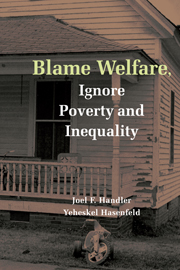Book contents
- Frontmatter
- Contents
- Acknowledgments
- List of Acronyms
- 1 Introduction
- 2 The State of Poverty: TANF Recipients
- 3 The Response to Poverty and Inequality: The Welfare State
- 4 Demonizing the Single-Mother Family: The Path to Welfare Reform
- 5 The Welfare Bureaucracy
- 6 Work and the Low-Wage Labor Market: Mothers and Children
- 7 Welfare Reform and Moral Entrepreneurship: Promoting Marriage and Responsible Parenthood and Preventing Teenage Pregnancy
- 8 Addressing Poverty and Inequality
- References
- Author Index
- Subject Index
6 - Work and the Low-Wage Labor Market: Mothers and Children
Published online by Cambridge University Press: 20 August 2009
- Frontmatter
- Contents
- Acknowledgments
- List of Acronyms
- 1 Introduction
- 2 The State of Poverty: TANF Recipients
- 3 The Response to Poverty and Inequality: The Welfare State
- 4 Demonizing the Single-Mother Family: The Path to Welfare Reform
- 5 The Welfare Bureaucracy
- 6 Work and the Low-Wage Labor Market: Mothers and Children
- 7 Welfare Reform and Moral Entrepreneurship: Promoting Marriage and Responsible Parenthood and Preventing Teenage Pregnancy
- 8 Addressing Poverty and Inequality
- References
- Author Index
- Subject Index
Summary
The central feature of welfare reform is work in the paid labor market. Not only will paid work reduce the rolls, costs, fraud, and poverty but also will reform the poor. It is through paid labor that parents will provide the proper role models for the socialization of the children. The work ideology at the federal level was first adopted with the Work Incentive Program (WIN) program in 1967, and, at least nationally, represented a fundamental change in the conception of the family. Before 1967, it was believed that the proper role of the mother was to stay at home and raise the family. Now, the proper role is paid employment, which eventually culminated in the 1996 welfare reform.
There are a number of assumptions – or myths – that support the work strategy: that there are sufficient jobs, that employers will hire welfare recipients, that welfare recipients have to be required to work, that the children of welfare leavers will be adequately cared for, that the family will have adequate health support, and that working in these jobs will reduce poverty. The entire family will be better off when supported by earned income. In this chapter, we explore these myths.
The chapter is divided into two parts that are intimately connected with each other. First, we consider single mothers and the low-wage labor market. What kinds of jobs are available?
- Type
- Chapter
- Information
- Blame Welfare, Ignore Poverty and Inequality , pp. 238 - 281Publisher: Cambridge University PressPrint publication year: 2006

